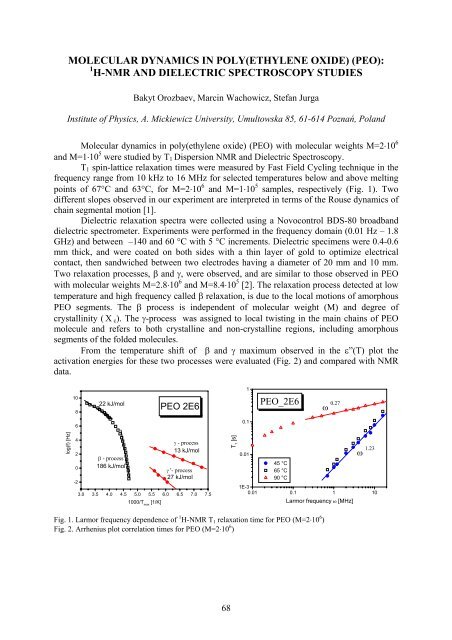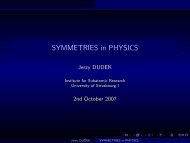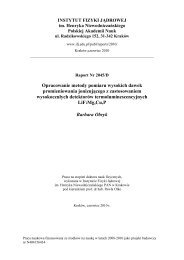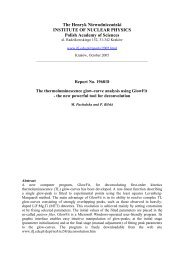Report No xxxx - Instytut Fizyki JÄ drowej PAN
Report No xxxx - Instytut Fizyki JÄ drowej PAN
Report No xxxx - Instytut Fizyki JÄ drowej PAN
You also want an ePaper? Increase the reach of your titles
YUMPU automatically turns print PDFs into web optimized ePapers that Google loves.
MOLECULAR DYNAMICS IN POLY(ETHYLENE OXIDE) (PEO):<br />
1 H-NMR AND DIELECTRIC SPECTROSCOPY STUDIES<br />
Bakyt Orozbaev, Marcin Wachowicz, Stefan Jurga<br />
Institute of Physics, A. Mickiewicz University, Umultowska 85, 61-614 Poznań, Poland<br />
Molecular dynamics in poly(ethylene oxide) (PEO) with molecular weights M=2⋅10 6<br />
and M=1⋅10 5 were studied by T 1 Dispersion NMR and Dielectric Spectroscopy.<br />
T 1 spin-lattice relaxation times were measured by Fast Field Cycling technique in the<br />
frequency range from 10 kHz to 16 MHz for selected temperatures below and above melting<br />
points of 67°C and 63°C, for M=2⋅10 6 and M=1⋅10 5 samples, respectively (Fig. 1). Two<br />
different slopes observed in our experiment are interpreted in terms of the Rouse dynamics of<br />
chain segmental motion [1].<br />
Dielectric relaxation spectra were collected using a <strong>No</strong>vocontrol BDS-80 broadband<br />
dielectric spectrometer. Experiments were performed in the frequency domain (0.01 Hz – 1.8<br />
GHz) and between –140 and 60 °C with 5 °C increments. Dielectric specimens were 0.4-0.6<br />
mm thick, and were coated on both sides with a thin layer of gold to optimize electrical<br />
contact, then sandwiched between two electrodes having a diameter of 20 mm and 10 mm.<br />
Two relaxation processes, β and γ, were observed, and are similar to those observed in PEO<br />
with molecular weights M=2.8⋅10 6 and M=8.4⋅10 5 [2]. The relaxation process detected at low<br />
temperature and high frequency called β relaxation, is due to the local motions of amorphous<br />
PEO segments. The β process is independent of molecular weight (M) and degree of<br />
crystallinity ( Χ c ). The γ-process was assigned to local twisting in the main chains of PEO<br />
molecule and refers to both crystalline and non-crystalline regions, including amorphous<br />
segments of the folded molecules.<br />
From the temperature shift of β and γ maximum observed in the ε”(T) plot the<br />
activation energies for these two processes were evaluated (Fig. 2) and compared with NMR<br />
data.<br />
1<br />
10<br />
8<br />
22 kJ/mol<br />
PEO 2E6<br />
PEO_2E6 ω 0.27<br />
ω 1.23<br />
6<br />
0.1<br />
log(f) [Hz]<br />
4<br />
γ - process<br />
2<br />
13 kJ/mol<br />
β - process<br />
0 186 kJ/mol<br />
γ '- process<br />
27 kJ/mol<br />
-2<br />
3.0 3.5 4.0 4.5 5.0 5.5 6.0 6.5 7.0 7.5<br />
1000/T max<br />
[1/K]<br />
T 1<br />
[s]<br />
0.01<br />
45 °C<br />
65 °C<br />
90 °C<br />
1E-3<br />
0.01 0.1 1 10<br />
Larmor frequency ω [MHz]<br />
Fig. 1. Larmor frequency dependence of 1 H-NMR T 1 relaxation time for PEO (M=2⋅10 6 )<br />
Fig. 2. Arrhenius plot correlation times for PEO (M=2⋅10 6 )<br />
68

















